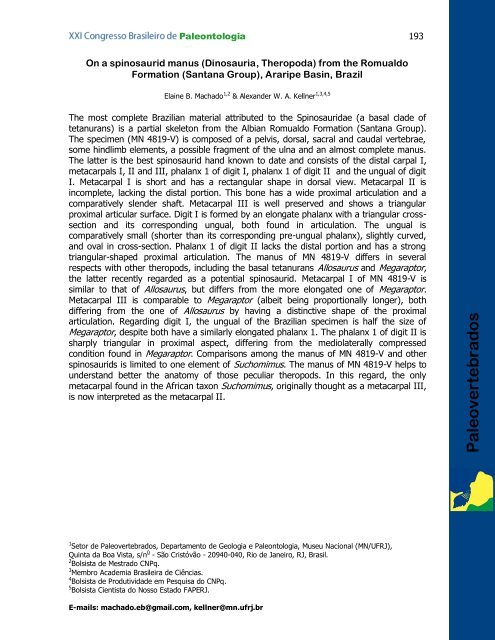Livro de Resumos - Dinossauros do Maranhão
Livro de Resumos - Dinossauros do Maranhão
Livro de Resumos - Dinossauros do Maranhão
Create successful ePaper yourself
Turn your PDF publications into a flip-book with our unique Google optimized e-Paper software.
Paleontologia 193<br />
On a spinosaurid manus (Dinosauria, Theropoda) from the Romual<strong>do</strong><br />
Formation (Santana Group), Araripe Basin, Brazil<br />
1 Setor <strong>de</strong> Paleovertebra<strong>do</strong>s, Departamento <strong>de</strong> Geologia e Paleontologia, Museu Nacional (MN/UFRJ),<br />
Quinta da Boa Vista, s/n 0 - São Cristóvão - 20940-040, Rio <strong>de</strong> Janeiro, RJ, Brasil.<br />
2 Bolsista <strong>de</strong> Mestra<strong>do</strong> CNPq.<br />
3 Membro Aca<strong>de</strong>mia Brasileira <strong>de</strong> Ciências.<br />
4 Bolsista <strong>de</strong> Produtivida<strong>de</strong> em Pesquisa <strong>do</strong> CNPq.<br />
5 Bolsista Cientista <strong>do</strong> Nosso Esta<strong>do</strong> FAPERJ.<br />
Elaine B. Macha<strong>do</strong> 1,2 & Alexan<strong>de</strong>r W. A. Kellner 1,3,4,5<br />
The most complete Brazilian material attributed to the Spinosauridae (a basal cla<strong>de</strong> of<br />
tetanurans) is a partial skeleton from the Albian Romual<strong>do</strong> Formation (Santana Group).<br />
The specimen (MN 4819-V) is composed of a pelvis, <strong>do</strong>rsal, sacral and caudal vertebrae,<br />
some hindlimb elements, a possible fragment of the ulna and an almost complete manus.<br />
The latter is the best spinosaurid hand known to date and consists of the distal carpal I,<br />
metacarpals I, II and III, phalanx 1 of digit I, phalanx 1 of digit II and the ungual of digit<br />
I. Metacarpal I is short and has a rectangular shape in <strong>do</strong>rsal view. Metacarpal II is<br />
incomplete, lacking the distal portion. This bone has a wi<strong>de</strong> proximal articulation and a<br />
comparatively slen<strong>de</strong>r shaft. Metacarpal III is well preserved and shows a triangular<br />
proximal articular surface. Digit I is formed by an elongate phalanx with a triangular crosssection<br />
and its corresponding ungual, both found in articulation. The ungual is<br />
comparatively small (shorter than its corresponding pre-ungual phalanx), slightly curved,<br />
and oval in cross-section. Phalanx 1 of digit II lacks the distal portion and has a strong<br />
triangular-shaped proximal articulation. The manus of MN 4819-V differs in several<br />
respects with other theropods, including the basal tetanurans Allosaurus and Megaraptor,<br />
the latter recently regar<strong>de</strong>d as a potential spinosaurid. Metacarpal I of MN 4819-V is<br />
similar to that of Allosaurus, but differs from the more elongated one of Megaraptor.<br />
Metacarpal III is comparable to Megaraptor (albeit being proportionally longer), both<br />
differing from the one of Allosaurus by having a distinctive shape of the proximal<br />
articulation. Regarding digit I, the ungual of the Brazilian specimen is half the size of<br />
Megaraptor, <strong>de</strong>spite both have a similarly elongated phalanx 1. The phalanx 1 of digit II is<br />
sharply triangular in proximal aspect, differing from the mediolaterally compressed<br />
condition found in Megaraptor. Comparisons among the manus of MN 4819-V and other<br />
spinosaurids is limited to one element of Suchomimus. The manus of MN 4819-V helps to<br />
un<strong>de</strong>rstand better the anatomy of those peculiar theropods. In this regard, the only<br />
metacarpal found in the African taxon Suchomimus, originally thought as a metacarpal III,<br />
is now interpreted as the metacarpal II.<br />
E-mails: macha<strong>do</strong>.eb@gmail.com, kellner@mn.ufrj.br<br />
Paleovertebra<strong>do</strong>s


